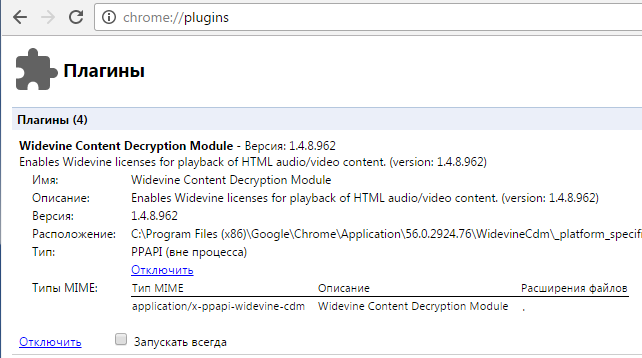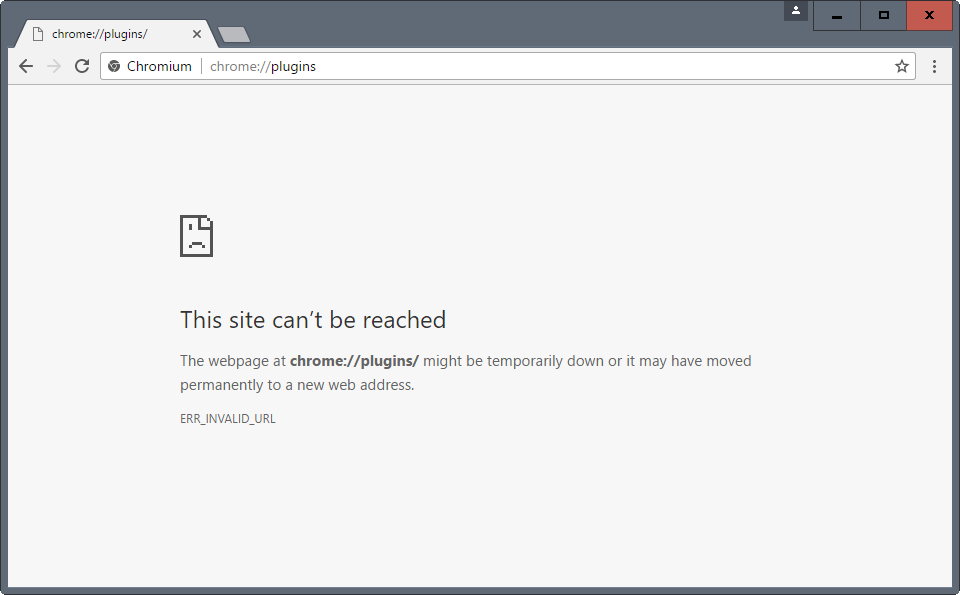DRM-plugin is fully integrated in Chrome 57: it does not turn off in the settings

Chrome: // plugins settings in the Chrome 57 browser will not
The new version of Chrome 57 is expected several changes. It is possible that this version implements the suppression of activity in the background tabs , which should significantly improve performance and reduce browser power consumption. Google’s other “optimization” raises many more questions. In the just released version of Chrome 56, the Widevine CDM, NaCL and others plugins are automatically activated every time the browser is restarted (even if you manually disable them). And in the beta version of Chrome 57, the familiar
chrome://plugins page to enable / disable plug-ins were completely removed as unnecessary!This is supposedly a technical change, because of the plugin to be disabled in the browser now only Flash and Chrome PDF Viewer remain. These plugins can be managed through the standard browser settings.

')
So a separate
chrome://plugins window can be considered redundant and redundant. “Such a change [deleting the chrome://plugins page] will make managing the Flash Player plugin more explicit and detectable through the settings (because most users probably know what Flash is, but they don’t know what a plug-in is) and consolidates the Flash Player modes ( for example, Plugin Power Savings mode) in one place ”, - this explanation is given in ticket 615738 , which is dedicated to removing chrome://plugins . This problem is already “fixed” and the ticket is closed, that is, the developers made the necessary changes in the code and deleted the “unnecessary” page.According to some commentators, Google’s actions are similar to boiling a living frog in boiling water. She suspects nothing if the water is heated not sharply, but gradually.
The main question beyond the discussion in ticket 615738 is how to disable the proprietary Widevine / EME plugin, which is responsible for the operation of the digital rights management (DRM) system in the browser. Now you can at least temporarily disable it, but in Chrome 57 the method of deactivation will disappear altogether. Widevine plugin will always be included.
Some are unhappy with this change in browser operation. On this occasion, the ticket 686430 was opened with a request to return the possibility of deactivating the Widevine / EME plugin. The argument is that the playback of encrypted streaming content violates the stability of the work - the browser often falls. Encrypted content activates the HDCP protection protocol during transmission over HDMI, causing characteristic screen blinks - and if you open a lot of tabs with EME, the HDMI splitter does not cope with the load. Claims are related to the fact that the described artifacts can no longer be avoided, since the plugin is enabled by default and is activated on any page with HTML EME (EME - Encrypted Media Extensions encrypted communications standard, which allows you to pack HTML5 video into DRM wrapper without the need for third-party Flash-like modules and Silverlight).
All these are minor technical flaws, but the main complaint to the Chrome developers is that they activate the default plugin for everyone and thus try to turn DRM into a standard platform for distributing video content. According to statistics, it now turns out that 99.99% of Chrome users have an installed and active DRM plugin, so all web developers will be able to use this “standard” technology of rights management and content encryption, as if it were an open web standard.
Now on the
chrome://plugins page there is a “Disable” button for the Widevine Content Decryption Module plugin. It is valid only for the current working session. After restarting the browser in Chrome 56, the plugin is automatically re-activated.In Chrome 57, users generally won't have the regular ability to disable the plug-in even for the current session. The
chrome://plugins tab will disappear from the free Chromium browser.
Thus, the user generally takes control over any plugins in the Chrome browser, except for Flash and Chrome PDF Viewer. It turns out that Google now considers all other plugins an integral integrated part of the browser.
As a workaround, if you want to disable DRM in the browser, you can simply delete the folder with Chrome plugins. It will be restored during the next Chrome update. After that, delete again. The procedure is repeated until Google does not figure out how to hide the plugin in the browser's code more cunningly. Now the plugin is placed approximately along this path (depending on the system):
C: \ Program Files (x86) \ Google \ Chrome \ Application \ [Chrome Version] \ WidevineCdm \
Delete this folder and restart the browser.
It remains to hope that the developers of other browsers on the engine Blink (Vivaldi, Opera) will not follow the example of the “big brother” and will leave users with the ability to manage plugins. The same goes for Firefox developers. It seems that Mozilla developer Robert O'Callahan was right, who in 2014 wrote the article “ Choose Firefox Now, otherwise tomorrow you will have no choice .” To date, Chrome has already captured 51.06% of the browser market ( 62.66% on desktops). O'Callahan looked like in the water.
In Firefox, the EME module is easily disabled. Moreover, Mozilla distributes a completely free version of Firefox from the crypto module EME (see the EME-free folders ).
Source: https://habr.com/ru/post/373117/
All Articles